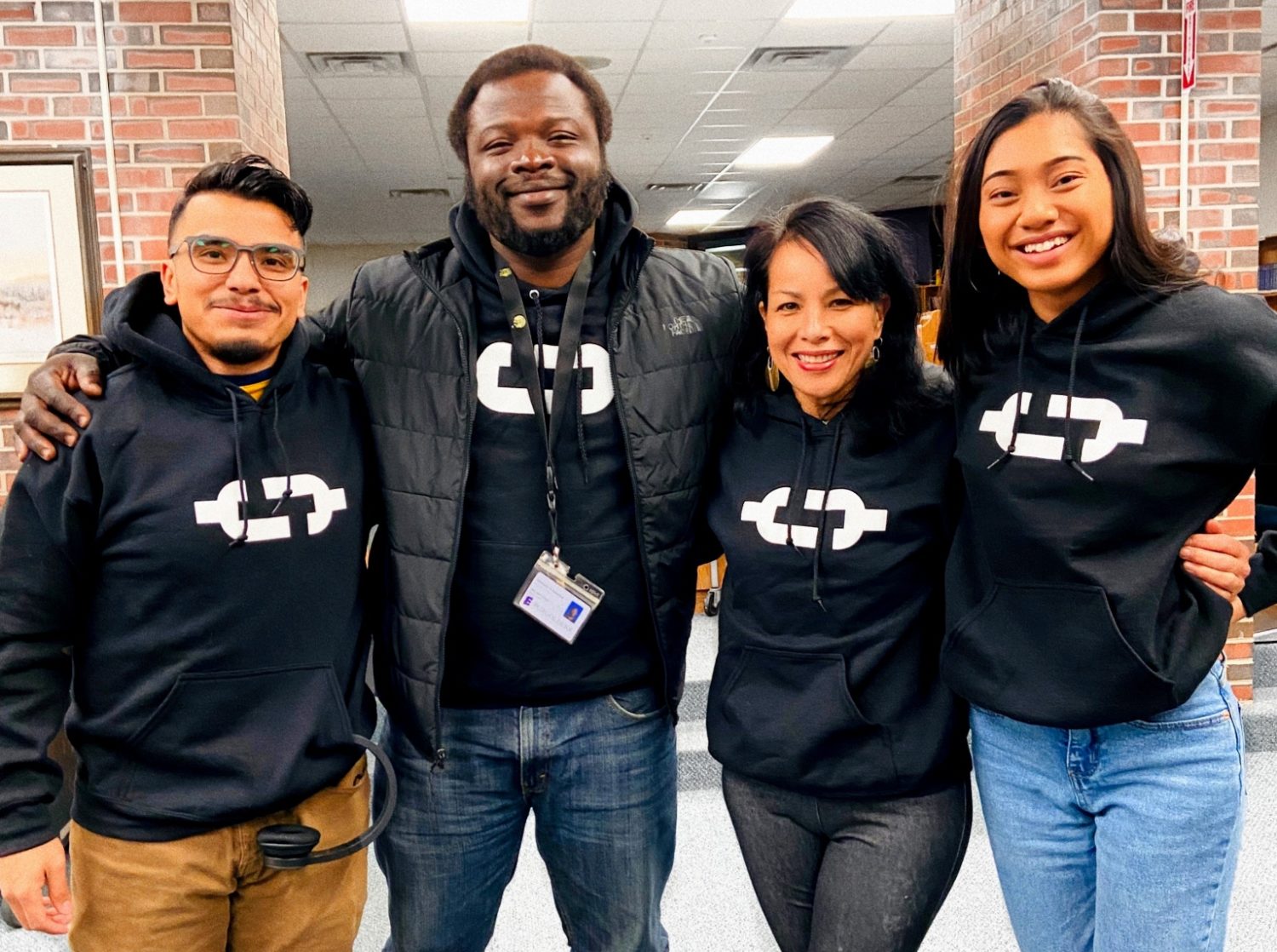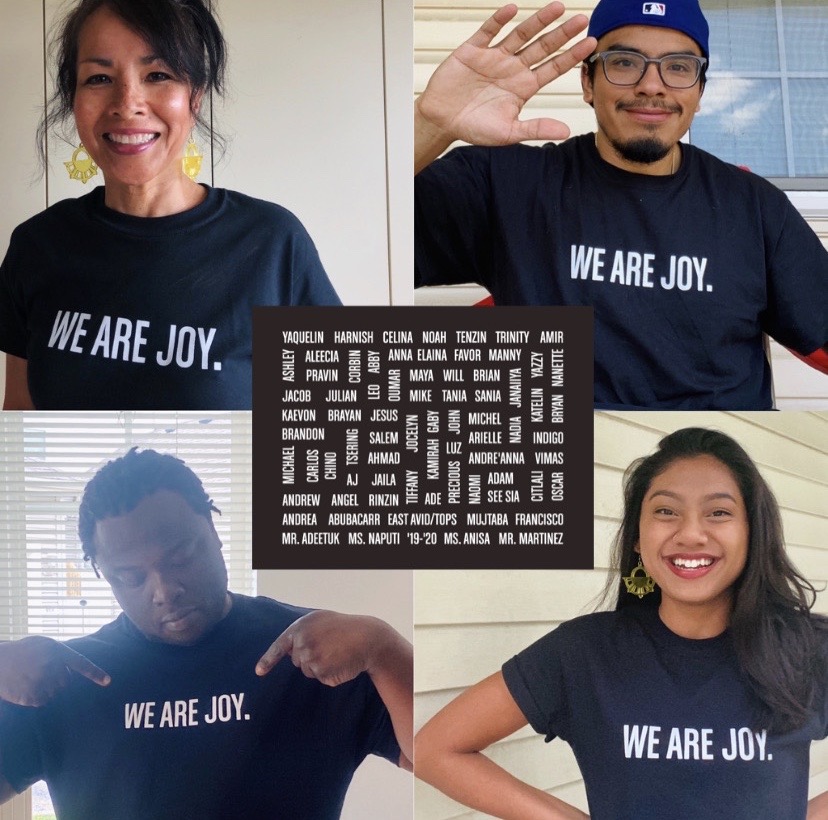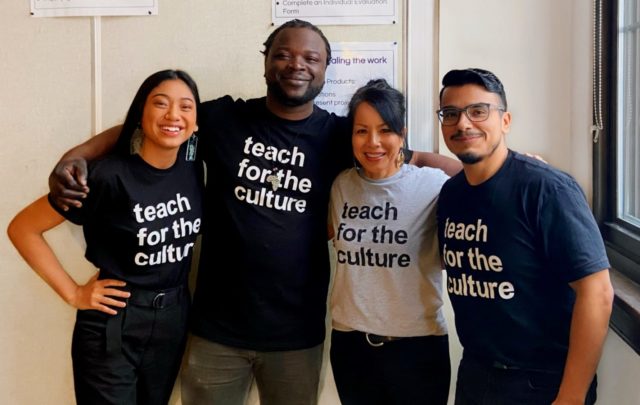 We’re looking back on some bright moments in a difficult year, and asked each member of our team to name a few of their favorite stories. This is one of Fatoumata Ceesay’s.
We’re looking back on some bright moments in a difficult year, and asked each member of our team to name a few of their favorite stories. This is one of Fatoumata Ceesay’s.
For the past year at Madison East High School, a four-member team — composed of brown and Black educators — has been providing support for their students in new ways and making waves throughout the district.
Cesar Martinez, Anisa Yudawanti, Vera Naputi and Kennedy Adeetuk work with 10th-grade students who are part of the Advancement Via Individual Determination (AVID) program. This program aims to close the achievement gap by preparing students — typically from traditionally marginalized communities or low-income backgrounds — for college and career readiness.
As the first teaching team of color at East, these four are uniquely positioned to authentically cater to their students. Throughout the year, these four have left a mark at East, a feat considering the team came together by happenstance, Yudawanti, a TOPS coordinator, said.
“This team came together in September,” she said. “Cesar, Vera and Kennedy all happened to teach the same grade level of AVID since last year. The school district has a partnership with the Boys and Girls Club of Dane County, and as a TOPS coordinator, I act as a liaison between the two, based every day at East High School. When I came to East, I was assigned to work with this grade level as well. So, luck is what you could call it, but if you ask any of us on any day, it truly feels like divine intervention of some sort.”
How they support students
This AVID team meets regularly to plan curriculum centered around students’ needs and voices. In addition, the team focuses on community building not only within their own students, but also throughout the larger AVID 10th-grade cohort.
To do this, the team has put together creative events geared toward their students’ interests. This includes the team taking their students to see Hamilton at Overture Center, organizing a private screening of Just Mercy at a local movie theater, and prior to COVID-19, the team was in the process of planning a service project on supporting racial justice-focused community organizations. Due to the pandemic and subsequent school closures, they had to pause in-person planning, but they hope to continue when they can be together in person, Yudawanti said.
“We meet regularly and talk and text every single day,” Naputi said. Naputi had been working as an AVID teacher with Martinez and Adeetuk for two years before Yudawanti joined them to form this team. “As their teachers, we focus on colleges and careers, and investigating those areas in multiple ways. We see our students through the lens of reality and that’s pretty much our pedagogical practice. We have structured dialogues, and invite students to co-plan and co-teach with us. Our students come to our weekly planning meetings so we can get input from them. We listen intently to their interactions and read their work to find the nuances that tell us things about them.”

“We took our students to see Hamilton at the Overture, which, for many of our students, was the first time they were able to have an experience like this,” Yudawanti said. “With our students, we reveled in conversations about what a brilliant production it was, while also discussing and asking questions of the barriers our families and communities have in being a part of this kind of experience.”
“Unofficially,” Martinez, who is also a U.S. History teacher, said, “We are in constant communication with each other because we love to share knowledge amongst the group and build each other up; this is how we also approach the work we do with our students.”
Since the shift to virtual learning, the team, like many other educators, had to approach school in a different way. For Adeetuk, who is an AVID instructor, English teacher and the English Department chairperson, virtual learning shed a light on some of the practices educators had fallen into.
“Teachers, myself included, have long been too focused on checking boxes and following scopes and what not and are less attuned to their student’s well-being and emotions,” he said. “Virtual learning has opened many teachers’ eyes to what the bigger picture is and what their roles are in their students’ lives.”
Adeetuk used virtual learning as an opportunity to encourage discussions with his students.
“It is evident that many students would rather converse about real-world happenings than their teachers’ assignments,” he said. “My discussions with my students have ranged from civil rights and the civil protests that are currently taking place nationwide, to stage lighting at the Bartell Theater for a mid-2000 production of Fiddler on the Roof. The takeaway for me was that some students relished this opportunity to share what was on their mind, good or bad.”
Along with hearing more from the students, the team continued to encourage regular meetings, now online. Every other day at noon, they had virtual lunch sessions where students had the opportunity to share their day or just be in the same space.
They also hosted a virtual movie night to watch Michelle Obama’s Becoming, held virtual raffles for Uber-eats gift cards to boost spirits, celebrated students’ birthdays on Zoom and most interestingly, engaged with students on social media through the popular app Tik Tok.
“The students are amazing and understanding and were willing to try new learning methods while providing feedback,” Martinez said. “For us, Zooms were not used to deliver school content, they were used to continue to build those relationships with our students and [we] left it open for whomever wanted to show up. The power of relationships is in the power of reaching out.”
They also built their community by creating shirts to match the ones the team had.
“While we were still in school, our students often pointed out our matching shirts and sweaters with a pointed, ‘how come the students don’t get to match too?’ So, we designed shirts with all of our students’ names on the back, and a simple, to the point phrase across the chest: ‘We are joy’ because time and time again, we have learned that that is what we are. We then hand-delivered each of these shirts to our student’s homes. It has been soul-feeding to see students light up as they wear them as a reminder of our collective joy,” Yudawanti said.
For them, being a Black and Brown team centered on student voices is an integral part of their mission. When planning for lessons, they frame it from the student’s points of views, Adeetuk said.
They “act on [their] originality” that comes from thinking “beyond colonized curriculum and sets of preordained rules,” Naputi said.
“Students know that their teachers are Black and Brown adults who have experienced many of the same things that they are experiencing as well. This is huge. Being ‘culturally relevant’ is important, but being ‘culturally relevant’ from lived experience is especially powerful,” Yudawanti said.
Their efforts have not gone unnoticed. A few weeks ago, an MMSD representative, Cynthia Moore, reached out to the team for a proposed project that would implement some of their strategies district-wide.
“The project that I am proposing for the AVID 10 team at East High School is a webinar or professional development on how they as a team have created safe, just and equitable learning spaces that support, affirm and foster identity in youth with a focus on Black, Indigenous, People of Color (BIPOC)/LGBTQIA+ students,” Moore said. “The proposed project supports the work we are doing at the district level to deliver social-emotional learning in a way that centers the sociopolitical and racial context of our students. ”
For the team, this was an affirmation that their work was important and recognized.
“I was the initial contact person for that,” Naputi said. “I realized that my team is crucial. We each have vision, but when we are together we brew the most radical meaningful things. So I proposed that we’d come as a team and they were all in.”
“I am excited to do some serious reflection and unpacking of our team’s work from this year to see how we can replicate this work for students across the district. So much of this year has been grounded in how we as teachers are able to bring and uplift our own identities in order to allow students to do the same, and packaging or summarizing how we do that will be challenging. I am grateful that I have the opportunity and privilege to work alongside powerful educators who want to see all students receive this kind of support and love,” Yudawanti said.
Looking ahead to the summer and fall
During the summer break, the team will continue to meet regularly and plan for the upcoming school year, including introducing new curriculum and modifying existing ones. Though it is still unclear whether or not MMSD will resume in-person teaching in the fall, the team is still planning. A big part of their planning will center around the aftermath of the pandemic.

“Coming into this upcoming school year,” Adeetuk said, “it is even more critical to build community and support for our AVID students as they struggle to deal with the aftermath of the pandemic. School is not going to look the same when we get back, and it is our job to limit the adverse effects that they experience from this traumatic event.”
Specifically, the team plans to incorporate the dramatic societal shifts — including the recent protests after the killings of George Floyd, Breonna Taylor, Ahmaud Arbery and more — into their AVID curriculum in an effort to help their students process and reflect on the events.
Challenges to their work
The work this team does comes with its own set of challenges, including attempting to work with students in a “typical” school structure.
“There are certain boundaries a program like ours has that requires us to follow a prescriptive set of core instructional tenants,” Adeetuk said. “In many ways, these tenants can be antiquated and do more harm than good, presenting challenges to us as we try to meet our students’ various needs.”
“I’d say the challenge is knowing and understanding that we are doing work in colonized spaces,” Naputi said. “It challenges me to know the work we’re doing has “worked” for so many students, so why buck the data. But it’s at the expense of allowing students full identities to be the primary text of the classroom, and that is what we brace ourselves against as we make decisions that might not fit the structure of ‘school.’”
Still, the passion for working with students is what drives the team to continue the work they do.
“The students that I get to work with are the most brilliant minds and spirits I have ever encountered, and I mean that,” Yudawanti said. “It is a privilege to be able to even be within proximity to their growth, learning and unlearning unfolding. My faith amidst all of the chaos erupting in our world comes from knowing that our young people are disrupting, asking the questions that others are too afraid to ask, and making waves and will continue to do so in the future. ”
More so, the originality and experience they all bring allow them to strengthen their team bond.
“This work wouldn’t be possible without the creativity and strength that each of us brings. Vera, Kennedy, and Anisa are people you need to get to know if you are in the educational world,” Martinez said.




























